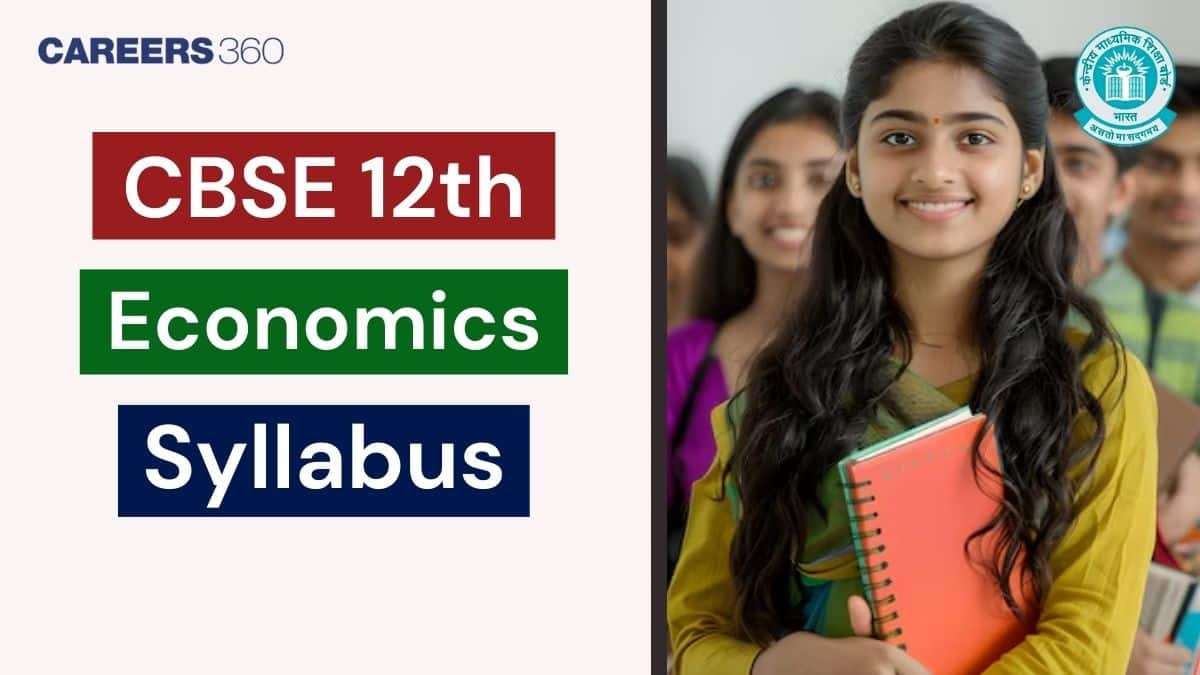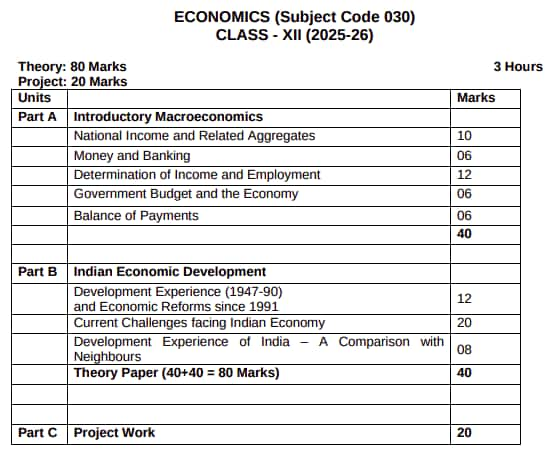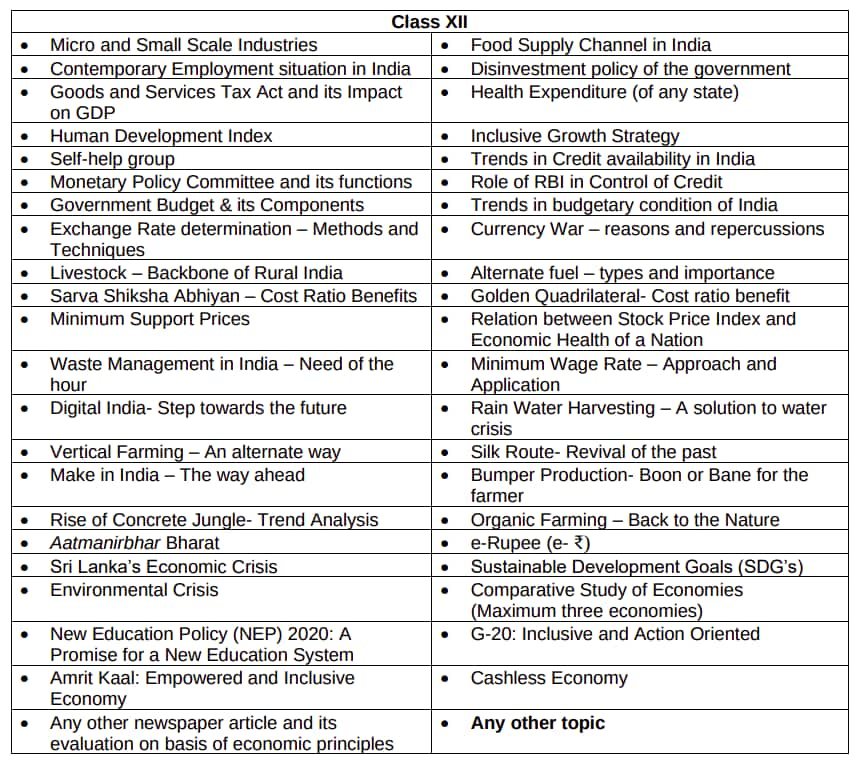CBSE Class 12 Economics Syllabus 2025-26 Download Free PDF | Macroeconomics & Indian Economy
CBSE Class 10th Exam Date:01 Jan' 26 - 14 Feb' 26
CBSE Class 12 Economics Syllabus 2025-26 - The Central Board of Secondary Education released the latest CBSE syllabus of Economics Class 12. The CBSE Class 12 Economics syllabus 2025-26 is available on cbseacademic.nic.in. The CBSE board has divided the entire syllabus into two parts: Part A (Introductory Macroeconomics) and Part B (Indian Economic Development). All the topics of the economics syllabus class 12 CBSE are important for board exams.
Download: CBSE Class 12 Economics Syllabus 2025-26 PDF
This Story also Contains
- How to Download CBSE Class 12 Economics Syllabus 2025-26?
- CBSE Class 12 Economics Syllabus 2025-26
- CBSE Class 12 Preparation Tips

Students should refer to the Economics class 12 CBSE syllabus to prepare for the CBSE 12th exams. Topic-wise weightage of marks is also mentioned in the Economics syllabus of class 12 CBSE. Students can find an overview and detailed CBSE Class 12 Economics syllabus in this article, along with a download link to the CBSE Economics syllabus 12th Class. Students should check each topic and understand the concepts better to score good marks in the final exams. Read further to know in detail the complete CBSE Class 12 Economics syllabus 2025-26.
Other subject syllabus
How to Download CBSE Class 12 Economics Syllabus 2025-26?
Students can download the economics syllabus for class 12 for the CBSE board exam to prepare better. Go through the steps given below to download the Class 12 CBSE Economics syllabus 2025-26:
- Step 1: Visit the official website at cbseacademic.nic.in.
- Step 2: Click on the “Academic Website” on the homepage.
- Step 3: Click on the “Curriculum” from the list of options mentioned in the menu bar.
- Step 4: Select the “Curriculum 2025-26” from the dropdown menu.
- Step 5: Click on the “Senior Secondary Curriculum” link for the Class 12 syllabus.
- Step 6: Select the “Academic Subjects” link to download the Economics syllabus PDF.
- Step 7: Download the CBSE 12th Economics syllabus for 2025-26 for future reference.
CBSE Class 12 Economics Syllabus 2025-26
Students can check the prescribed Economics syllabus of class 12 CBSE in the image given below. The CBSE 12th Economics syllabus is divided into 2 parts. Part A consists of Macroeconomics, and Part B consists of Indian Economic Development. Students must note that the theory paper will have a weightage of 80 marks, while 20 marks are reserved for the project work. To understand better, students should thoroughly understand the syllabus of the Economics class 12 CBSE 2025-26. Check the image given below to get an overview of the CBSE class 12 Economics syllabus 2025-26.
Overview of CBSE Class 12 Economics Syllabus 2025-26

Detailed CBSE Class 12 Economics Syllabus 2025-26
The entire CBSE Economics class 12 syllabus is designed to be covered in approximately 200 periods. The written exam will carry a weightage of 80 marks, and 20 marks are allotted for the project work. Check the chapter-wise detailed CBSE Economics class 12 syllabus in the following tables:
Part A - Introductory Macroeconomics Syllabus
Unit-name | Chapters and Topics |
Unit 1: National Income and Related Aggregates |
|
Unit 2: Money and Banking |
|
Unit 3: Determination of Income and Employment |
|
Unit 4: Government Budget and the Economy |
|
Unit 5: Balance of Payments |
|
Part B: Indian Economic Development
Unit name | Chapters and Topics |
Unit 6 - Development Experience (1947-90) and Economic Reforms since 1991 |
|
Unit 7 - Current challenges facing the Indian Economy |
|
Unit 8: Development Experience in India |
|
Prescribed Books for CBSE Class 12 Economics Syllabus 2025-26
Below are some of the best books for the 12th economics syllabus for the CBSE exam. Check them out.
- Statistics for Economics, NCERT
- Indian Economic Development, NCERT
- Introductory Microeconomics, NCERT
- Macroeconomics, NCERT
- Supplementary Reading Material in Economics, CBSE
CBSE Class 12 Economics Project Topics

CBSE Class 12 Preparation Tips
- First of all, make a proper timetable to study, which includes all the subjects. Also, include some time for interests and hobbies to keep the mind fresh.
- Go through the CBSE 12th date sheet and try to cover the entire 12th CBSE Economics syllabus two months before the exams. In such a way, students will have enough time to revise the CBSE Class 12 Economics syllabus 2025-26.
- Grasp all the concepts from the NCERT books or prescribed books in the beginning, then move on to other reference books for economics.
- Clear all the doubts from teachers or friends and make notes on important topics of the CBSE class 12 Economics syllabus 2025-26.
- These notes will help to revise the entire CBSE 12th Economics syllabus in a short time.
- Solve CBSE class 12 question papers of previous years to get acquainted with the typology of questions that are asked in the exam.
- Analyse the preparation level by evaluating the performance in solving the question papers and improving mistakes by identifying them.
- Following this CBSE Class 12 Economics syllabus 2025-26 and preparation tips will aid students to improve their CBSE 12th result.
Related Links:
Frequently Asked Questions (FAQs)
Class 12 Economics question paper is prepared by the board as per the prescribed CBSE Class 12 Economics syllabus 2025-26.
Yes, it is essential to submit project work else students do not qualify in project work assessment.
A total of 200 periods are required to cover the CBSE 12th economics syllabus.
CBSE Class 12 Economics syllabus 2025-26 is divided into the following two parts:
- Part A - Introductory Macroeconomics Syllabus
- Part B - Indian Economic Development Syllabus
Questions related to CBSE Class 10th
On Question asked by student community
The CBSE Sahodaya Question Papers for Class 10 (2025-26) are not released centrally by the board as a single PDF.
Here is the essential information you need:
-
Local Release: The papers are designed and released by the individual Sahodaya School Clusters (groups of CBSE schools) just before or during the pre-board exam dates (typically held in December and January). Therefore, you must check your local cluster's portal or directly with your school administration.
-
Best Practice: The official model papers, based on the full 2026 syllabus, are the most reliable tool for practice. These accurately reflect the structure, format, and competency-based questions used in the Sahodaya exams.
You can download the latest CBSE Class 10 Model Papers to simulate the Sahodaya tests here: https://school.careers360.com/articles/sahodaya-question-paper-2025 . Focus on that pattern
Hi! If you’re looking for the Class 11 English half yearly question paper for 2025-26 (CBSE board), you’ll find the right resource once you check the link provided from Careers360. Solving previous or sample papers is a smart way to prepare, as it helps you understand the question types, marking scheme, and important topics. This practice will boost your confidence and help you manage your time well in the actual exam.
https://school.careers360.com/boards/cbse/cbse-class-11-half-yearly-sample-papers-2025-26
Hi dear candidate,
Could you please specify us the board of education for which you need the half yearly question papers of class X so that we can help you further.
Below are few links which may help you and it has all the subjects with English as well:
CBSE Class 10 Half Yearly Exam Question Paper 2025-26 with Answer Key & Analysis
ICSE Class 10 Half Yearly Sample Papers 2025-26 PDF (All Subjects)
BEST REGARDS
Hi dear candidate,
Can you please specify the board of education or state for which you need to know the exam pattern and syllabus so that we can guide you accordingly.
Since, most of the boards uses NCERT as base syllabus, you can refer to the link below:
NCERT Syllabus for Class 10 – All Subjects PDF Download 2025-26
Exam pattern:
CBSE 10th New Exam Pattern 2026- Marking Scheme, Subject-Wise Exam Pattern
BEST REGARDS
The CBSE Class 10th Board Exams for the 2026 session will follow the revised curriculum, emphasizing competency-based questions.
-
Conducting Body: Central Board of Secondary Education (CBSE).
-
Exam Period: The main theory exams are typically held between February and April 2026.
-
Grading: Based on marks in five main subjects plus internal assessment marks (often 20 marks per subject) provided by the school.
-
Passing Criteria: You must achieve at least 33% overall in each subject (theory + practical/internal assessment combined) to be declared pass.
Key Preparation Strategy
The most crucial element of your preparation is understanding the exam structure:
-
Syllabus: Strictly adhere to the rationalized syllabus released by CBSE for the 2025-26 academic year.
-
Practice: Your primary resource should be the latest sample papers and previous year question papers. These accurately reflect the format and types of competency questions being asked.
For the most comprehensive and official announcements, including the detailed time table and access to crucial practice materials, always check the official board updates, as tracked by Careers360: https://school.careers360.com/exams/cbse-class-10th .
Applications for Admissions are open.
As per latest syllabus. Physics formulas, equations, & laws of class 11 & 12th chapters
JEE Main Important Chemistry formulas
Get nowAs per latest syllabus. Chemistry formulas, equations, & laws of class 11 & 12th chapters
JEE Main high scoring chapters and topics
Get nowAs per latest 2024 syllabus. Study 40% syllabus and score upto 100% marks in JEE
JEE Main Important Mathematics Formulas
Get nowAs per latest syllabus. Maths formulas, equations, & theorems of class 11 & 12th chapters
